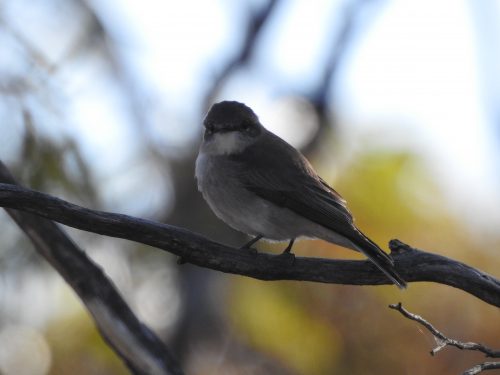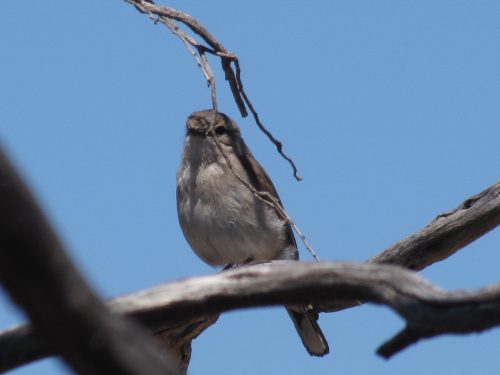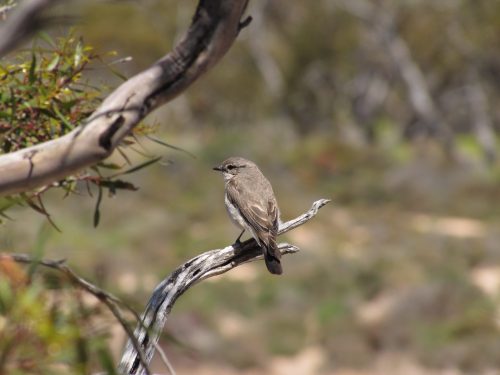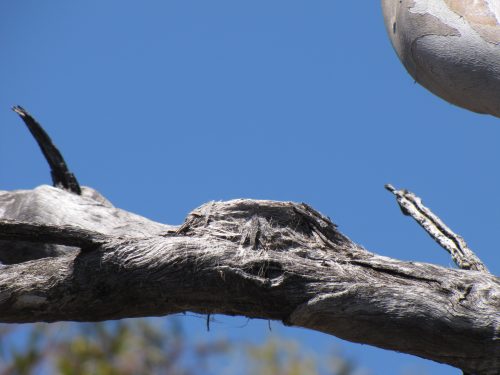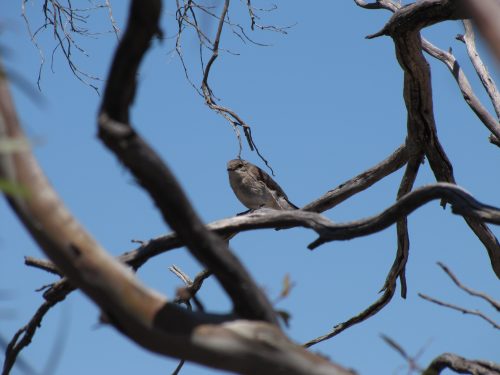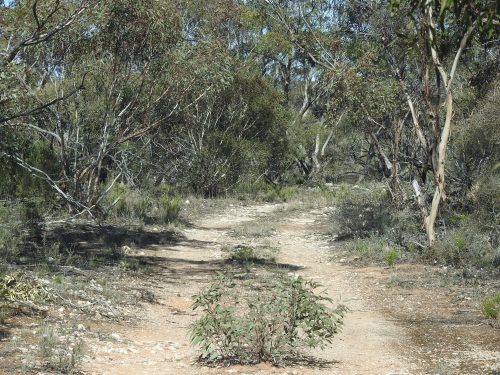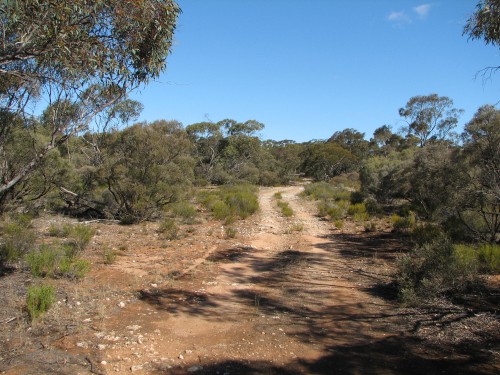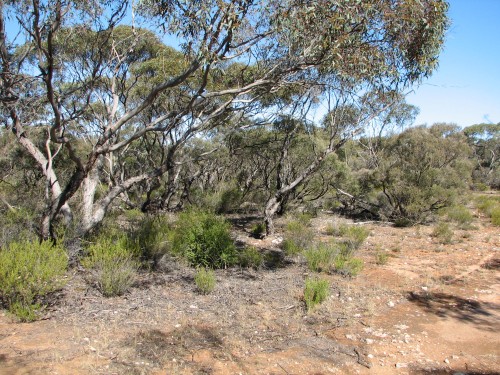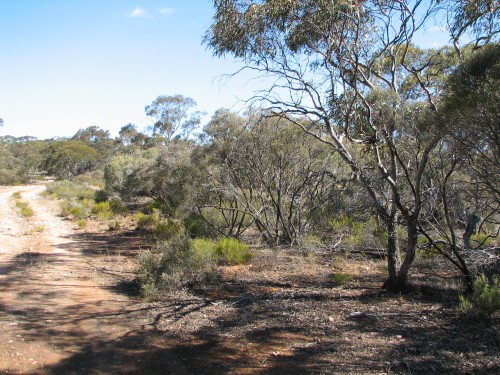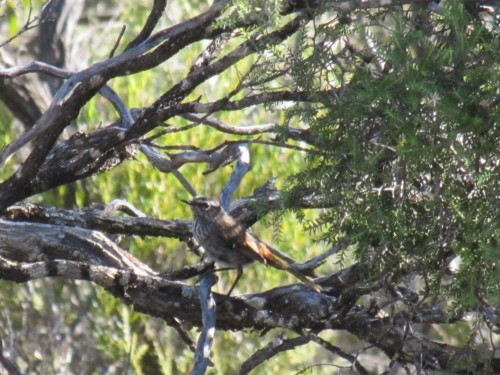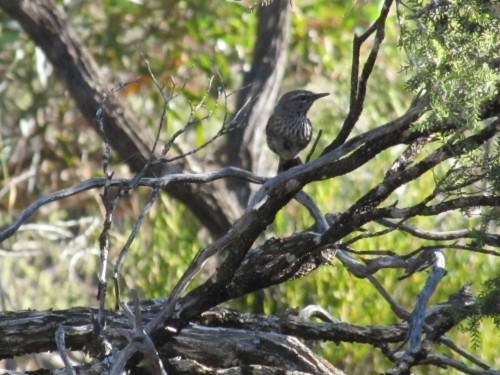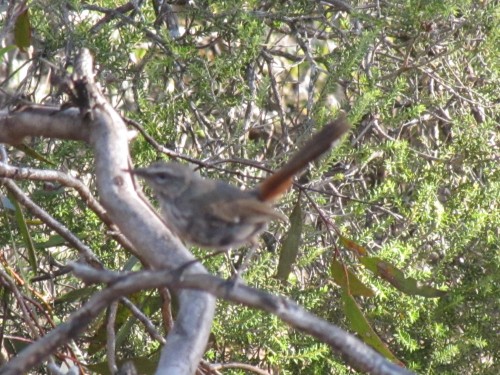Just a shy little Jacky Winter
Earlier this year I went for a Saturday afternoon drive to the Lowan Conservation Park near Bowhill north-east of my hometown of Murray Bridge, South Australia. I needed to get out of the house after some cold wintery weather, and my daughter had never been to this park. She had just returned home after teaching for the last two years in Ethiopia. The day promised to be sunny and calm, ideal for a picnic and a spot of birding. Over the years I have visited this small park in the mallee areas of our state on a few occasions and it sometimes throws up a few birding surprises.
As we had afternoon tea – a cuppa and some treats from our local bakery – we sat in the afternoon sunshine. My daughter had her current book to read (Tim Winton’s The Shepherd’s Hut) and I had my camera and binoculars at the ready. Flitting around in the nearby mallee trees was a Jacky Winter, one of our flycatcher species. It’s called a Jacky Winter possibly due to its call which sounds a bit like it is saying ‘jacky winter, jacky winter.’ At least, that’s what it sounds like to me. Another common name is ‘Peter Peter’ and that is probably a closer rendition of its call. Whatever the origin of the name, the bird is a generally unassuming little bird which can often go unnoticed in the Australian bush. More often it is sighted quietly sitting on a branch, a tree stump or fence post watching the surrounding grass intently, just waiting to snatch up a tasty morsel – a passing insect or two.
On this visit to the Lowan Conservation Park, I had good views of this bird, but I had trouble getting my camera focussed on this individual. It kept flitting around, catching afternoon tea and calling all the time. Every time I would try to focus – off it would go again. The only time it sat still enough for a shot in focus it was in the shade – see the photo above.
So that you can get a better view of this species, I have posted several photos taken two years ago in the Murray-Sunset National Park in north-west Victoria. These shots include the beginnings of a nest consisting mainly of a spider web.
Further reading:
Birding in Lowan Conservation Park
A few Sundays ago we had a break in our cold, wintry weather and we went for a drive to Lowan Conservation Park, a 40 minute drive north east from home in Murray Bridge, South Australia. The park is about 15 kilometres south east of Bowhill. I had visited this park on several previous occasions and found that the birding can be either a feast or a famine; it all depends largely on what is in flower, or the weather conditions.
The park is predominantly mallee woodland (see photos) with a mixture of other smaller scrubs and bushes. My wife has written about some of the plants on her site here.
On our most recent visit I didn’t even bother to take any photos; I saw no birds to photograph, well, none within range. And while we had our picnic afternoon tea in the sun I heard very little. It was a real struggle to get a short list of birds – mostly heard. (PS The photos on this post were taken on another visit.)
Bird list:
- Little Raven
- Mallee Ringneck
- Grey Shrike-thrush
- Weebill
- White-winged Chough
- Singing Honeyeater
- Australian Magpie
- Grey Butcherbird
- Galah
- Grey Fantail
- Noisy Miner? (or Yellow-throated Miner? – I only heard them)
- Striated Pardalote
That is not a great list, but there was not much flowering. In a park of some 660 hectares one would expect far more honeyeaters, but the mallee has to be in flower. Honeyeater species I would expect to see – or already have seen on other occasions – include: Striped, White-fronted, White-eared, White-plumed, Spiny-cheeked, Purple-gaped, Yellow-plumed, Brown-headed, New Holland and Red Wattlebird.
In addition to the honeyeaters I would expect to see more parrots, pigeons, wrens, thornbills, chats, woodswallows, robins (I did see one, but it flew off before I could get a positive ID), owls, nightjars, frogmouths, swallows, cuckoos, eagles, kites, falcons and even a Malleefowl or two. I have seen two Chestnut Quail-thrush there many years ago; I hope that they are still around.
I guess that the best time to visit would be in the spring, when there is a chance of more flowers. I think that it might be worth camping there overnight. By the way – there is only a rough, stony and sometimes sandy track through the park and NO facilities at all.
Trevor
Further reading:
A Shy Heathwren comes out of hiding
One of the more interesting birding spots near my home in Murray Bridge South Australia is Lowan Conservation Park near Bowhill, about a 40 minute drive to the north east. This park is mainly mallee eucalypt scrub with some native pine (Callitris) and smaller shrubby undergrowth, including acacias, eremophilas, spinifex and some annual flowering plants.
The birdlife in this park can vary from overwhelming in number to very few. It all depends upon what is flowering at the time. When many of the mallee trees are in flower the honeyeaters flock there in large numbers. When nothing is flowering I’ve struggled to list more than a dozen species – and sometimes no honeyeaters, with the possible exception of a solitary Red Wattlebird. It can be very rewarding – or downright frustrating.
On a visit early last year I was delighted to catch a glimpse of a Shy Heathwren, not a species which is common in this region. True to its name it proved to be elusive but very vocal. A birding friend had a bird field guide application on his phone, so he played the call of this species. Within seconds it was almost hopping around our feet. I was therefore able to get a few not-so-brilliant shots. Wish it had sat still for more than a half second!
As a result of this experience I just had to go and buy myself a smart phone – along with a bird guide app.
UPDATE: I have since bought a smart phone AND have a field guide app on it. I haven’t used it much for calls out bush, but my grandchildren think it is really cool. [sigh]
A more recent article about this park can be found here.
Updated July 2015.
Honeyeaters of Lowan Conservation Park
Lowan Conservation Park is a reserve of remnant mallee scrub in the midst of wheat and sheep farms. It is several hundred hectares in size with a rainfall of probably about 300mm in an average year. It is about 120km east of Adelaide in South Australia.
When the mallee trees are in flower the honeyeaters abound. I have visited when there have been no trees flowering and consequently very few honeyeaters. On other occasions I haven’t know where to point my binoculars first, there are so many birds. On these exciting occasions the birding is simply wonderful. I have observed the following species in or near the park:
- Red Wattlebird – resident and common
- Singing Honeyeater – resident and common
- White Eared Honeyeater – resident and common
- Spiny Cheeked Honeyeater – probably resident
- Brown Headed Honeyeater – resident and common
- Yellow Plumed Honeyeater – probably resident
- Striped Honeyeater – regular visitor spring, summer
- White Fronted Honeyeater – possibly resident
Other species which could occur when the conditions are right include:
- Purple Gaped Honeyeater
- Yellow Throated Miner
- White Plumed Honeyeater
- New Holland Honeyeater
- Black Honeyeater
- Tawny Crowned Honeyeater
Great Birding Moments # 21 Splendid Wren
A few days ago we went to visit Lowan Conservation Park, a relatively small patch of mallee scrub about 40 minutes drive north east of our home in Murray Bridge. This park can be very rewarding to the birder – or it can be extremely frustrating. It usually depends on what trees and bushes are in flower.
We arrived mid afternoon in bright sunshine with a gentle south westerly keeping conditions pleasant. We drove slowly through to a nice spot in about the middle of the park for an afternoon cuppa. As we stopped there were about 150 Dusky Woodswallows overhead, their lovely calls filling the sky. Within minutes they had moved on. (For a photo of a Dusky Woodswallow taken elsewhere click here and scroll down the page.)
All else was fairly quiet. A few Weebills called nearby and a Spiny-cheeked Honeyeater called a distance away. I could also hear a Magpie calling and a Grey Shrike-thrush called somewhere in the scrub nearby. During the twenty minutes break for our cuppa we didn’t see a bird. I had been hopeful of seeing a Chestnut Quail-thrush because we parked a few metres from where I had seen two of them on a previous visit. No luck there.
We drove very slowly back towards the entrance gate but stopped a short distance from it so Corinne could take a photo of some plants. To see the photos click here and here and here.
While she was taking the photos I wandered off into the scrub for about thirty metres. A sudden flash of colour in the low bushes nearby attracted my attention. For about ten seconds I had a great view of a male Splendid Fairy-wren in full breeding plumage. This has to be one of Australia’s most beautiful birds. I’ve only managed to see one on a few occasions. This area is one fairly reliable spot to observe this species.
The excitement of this sighting was shattered a little when I realised that my camera was in the car! By the time I’d collected the camera it had flown elsewhere and it wasn’t calling, so I couldn’t track it down. I tried to attract it by making kissing sounds (this usually works with wrens) but to no avail. So I haven’t a photo to show off. Instead you will have to be content with someone else’s photos here.
UPDATE: on my recent holiday in New South Wales I managed to get some reasonable photos of this beautiful species. Check out “A Splendid Result”
This post was updated on July 6th 2015.
